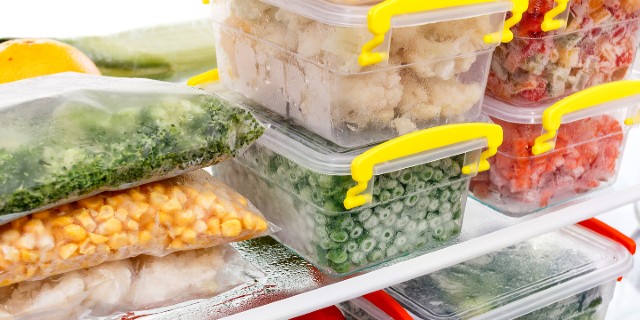Because of the diversity of products in your kitchen, packing frozen food for your relocation might be a challenge. Many items must be sorted out, from frozen food to perishables, before you begin packing anything. Furthermore, if you have a habit of piling stuff in your refrigerator, it could take hours to get started with the packing.
So, what is the answer? Regardless of the intricacy, you may pack your frozen food items with ease by following the step-by-step technique outlined below:
Make a list of food you’ll need to pack.
Before you begin wrapping jars and containers, make a list of the food products in your kitchen, including frozen food, and categorize them so that you can pack the goods together without damaging each other. It’ll also help you decide what to pack and leave behind.
Make sure you’re not wasting food and carrying as much frozen food as your capacity allows. Here’s how to transport frozen food and other refrigerated food when you move:
Make an inventory list.
As you go through your cupboards and fridge, write down all the food items you find. This will help you determine what needs to be used before moving and what remaining frozen food can be packed.
In the weeks leading to your move, make are to consume the ones that will go bad first and throw away any expired foods and frozen meat. Baking supplies must also be checked for bacterial growth and molds. Non perishables can also be donated to a local charity. Some of them will be happy to accept frozen items and food supply as long as they are still good for consumption.
Categorize your food items.
Once you have an inventory list, it’s time to start sorting your food into different categories:
- Pantry items: non-perishable items such as canned items, dry goods, spices, etc.
- Refrigerator items: perishable items such as milk, cheese, meat, produce, etc.
- Frozen items: frozen food such as ice cream, meat, vegetables, etc.
Begin packing according to the type of food.
Because each type of food must be handled differently, we have detailed the packaging processes for each category separately.
Here’s how to prepare your food for the move:
You can keep track of the number of perishable items in your freezer by making a list of what you have and then transferring them to your new home on moving day. Be sure to pack these items in an insulated bag or a portable freezer or cooler surrounded with cold packs.
You can also place them in sealable containers in the portable freezer so they will stay frozen for a few hours as the moving company transports your belongings to your new house.
Follow These Helpful Tips When Packing Food
Pack items such as cheese, butter, and cream in plastic bags, or packing paper and seal them tightly then place them in the freezer. These items need cold temperature to stay fresh.
Wrap bacon and sausage in foil or wax paper and store in the freezer.
For fish, first, wrap it in wax paper or aluminium foil, then place it in a plastic bag before putting it in the freezer.
To keep hamburgers and other ground meat fresh, place it in a plastic bag, remove as much air as possible, seal the bag, and store it in the freezer.
Pack eggs in their carton and store them in the fridge until you’re ready to move.
Place fruit juices and milk in glass bottles or cartons with tight-fitting lids and store them in the fridge. If you have dry ice you can place them with frozen food in a freezer when moving to help keep it for longer.
Pack fruits and vegetables in plastic bags and place them in the fridge.
Non-Perishable Foods
These food items do not require refrigeration and have a long shelf life, such as canned goods, cereals, pasta, rice, etc. You can leave them in their original packing or repack them in plastic containers or cardboard boxes. Here are some suggestions for packing non-perishable foods:
Canned goods can be loaded, but make sure you label them to know what’s inside each tin.
For items such as cereals, pasta, and rice, please place them in airtight plastic containers or resealable bags. This will keep them fresh and protect them from insects and rodents.
Allergy Information
If you or anyone in your family has food allergies, it is essential to label all the packing boxes accordingly. This will help you identify the allergen-free food items and keep them separate from the others.
Packing to Transport Frozen Food
If you’re moving a short distance, you can pack most of your food in a cooler. This would be particularly useful if you’re moving in the summer when high temperatures. Here’s what you need to do:
- Pack all the perishable items in the cooler, such as dairy products, meat, fish, eggs, etc.
- Pack non-perishable items such as canned goods, cereals, pasta, snacks, etc., in resealable bags or airtight containers.
- Pack the cooler with ice packs or dry ice to keep the food items chilled during the transfer.
- Packing food in a cooler is a good option if you’re moving a short distance.
Packing Frozen Food Items for Long-Distance Trips
If you’re moving to another state or country, it is best to donate any unopened non-perishable food items to a local food bank. There is a chance that the food would spoil throughout the long travel. If you have any perishable things, you can eat them before moving or donate them to friends and family.
Transporting Food By Yourself
If you’re moving the food items yourself, make sure you pack them properly to prevent them from going wrong during the journey. Here are some pointers to remember:
- Pack all the perishable items in an insulated bag or more relaxed.
- Pack non-perishable items such as canned goods, cereals, pasta, snacks, etc., in resealable bags or airtight containers.
- Pack the cooler with ice packs or dry ice to keep the food items chilled during the transfer.
Instructions to Store Frozen Food Items
On top of the suggestions above, there are a few other items to consider while packing food for a move. Here are a few essential tips:
- Ensure you have enough packing supplies, such as boxes, bags, tape, etc., to pack all the food items.
- Pack the food items in small batches to be moved easily.
- Pack the food items according to their type, such as perishable items, canned goods, etc.
- Make sure you label all the packing boxes to know what’s inside each box.
These are a few critical recommendations you need to follow while packing food for a move. Follow these guidelines to guarantee that your food is loaded accurately and safely.
What Happens When Food is Not Packed Properly?
When food is not packed correctly, it can spoil or become contaminated, leading to food poisoning or other illnesses. Each year, Australians experience an estimated 4.1 million foodborne illness cases, with hospitalizations and 78 deaths.
Packing food correctly is crucial to preventing these illnesses. Some tips for packing food safely include:
- Keep hot food hot and cold food cold. Use insulated bags or containers to keep food at the correct temperature.
- Wash your hands thoroughly. This is especially important before handling food eaten raw, such as fruits or vegetables.
- Avoid cross-contamination. Keep raw meat, poultry, and seafood separate from other food. Use different cutting boards and knives for these items.
- Pack food in airtight containers. This will keep out bacteria and other contaminants. Refrigerate perishable food. This includes food that contains raw meat, poultry, or seafood.
- Freeze items that won’t be used right away.
How Long Does Frozen Food Keep?
Frozen food can last for months or even years if stored properly. The key to storing frozen food is to keep it at 0 degrees Fahrenheit (-18 degrees Celsius), and this will prevent the growth of bacteria and other microorganisms that can cause food poisoning.
To ensure that your frozen food stays fresh, follow these tips: Store frozen food in a freezer set to 0 degrees Fahrenheit (-18 degrees Celsius).
Hiring Professional Movers
If you’re hiring professional movers, inform them about the food items that need to be moved. This is because most moving companies have a policy of not transporting perishable goods. So, it is best to either move the food items yourself or donate them before the move.
Conclusion
Packing food for a move can be challenging, but it is essential to do it correctly to prevent food spoilage or contamination. Use the tips in this article to ensure that your food is packed perfectly and stays fresh during the move.



